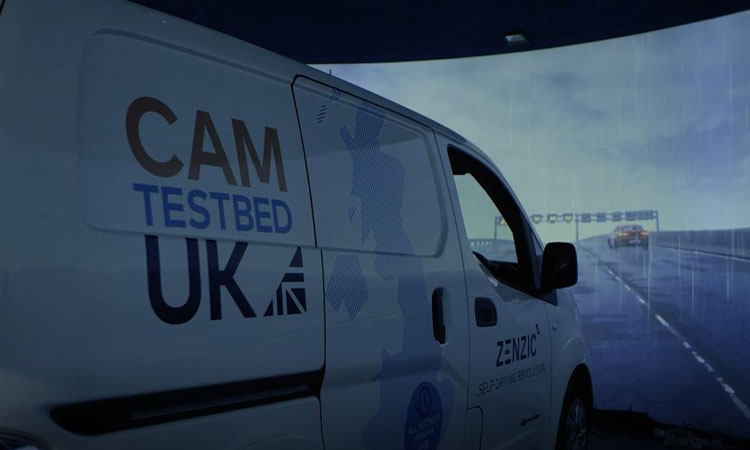The new insights of the updated report show where UK companies are well placed to deliver core elements of Connected and Autonomous Mobility.
Zenzic has revealed the UK’s strongest sectors in the development of self-driving vehicles in the UK as it launches the UK Connected and Automated Mobility Roadmap to 2030: CAM Creators Update.
The updated Roadmap shows the state of UK Connected and Automated Mobility (CAM), which areas the UK is leading in globally, and what challenges need to be tackled in the next 12 months to ensure we will be able to benefit from safe self-driving vehicles on roads in the next decade.
This update also highlights the tremendous progress which has been made by the 117 ‘CAM Creators’, each of whom has stepped forward in recent months to provide Zenzic with valuable data and insight to help paint a more accurate picture of where the UK stands across the different CAM sectors.
The state of UK Connected and Automated Mobility
The first edition of the UK Connected and Automated Mobility Roadmap to 2030, launched in September 2019, outlined several ‘key enablers’, activities and developments which need to be completed before many future sequential activities can even begin. Over the past 12 months, the UK Connected and Automated Mobility Roadmap to 2030 has been an instrumental tool for UK-based organisations making great strides in laying foundations around safety standards, cyber security planning, legal frameworks and defining vehicle and infrastructure data connectivity requirements. Specifically:
- The release of two publicly available specifications from the BSI, (PAS 1880 and PAS 1881) which tee-up safety standards for the testing of self-driving vehicles
- The Law Commissions has completed two consultations around automated vehicles, with the process due to be concluded in 2021
- The UNECE’s World Forum for Harmonization of Vehicle Regulations adopted two new regulations on cyber security and software updates. These tackle cyber security risks by establishing clear performance and audit requirements for vehicle manufacturers. The UK heavily contributed to these regulations, which are the first internationally harmonised and binding norms in this area.
The UK is also on track when it comes to defining the data requirements for vehicle and infrastructure data sharing. Both through work on the A2M2 connected corridor as part of the EU’s InterCor project, and the development of the geodata report by Zenzic and Ordnance Survey which provides recommendations for high-definition mapping data.
What the second edition of the Roadmap adds and reveals
The second edition of the UK Connected and Automated Mobility Roadmap to 2030: CAM Creators Update adds a range of features designed to make collaboration across the UK self-driving development industry easier. Roadmap activities have been assigned topic-based tags, which make it easier for organisations to find relevant Roadmap activities and see who they can collaborate with. The new Roadmap also debuts ‘CAM Creators’, 117 companies who have identified themselves as having a core role in the development of CAM services and technology. Roadmap users can find which CAM Creators are active in their relevant sector and connect with them.
The tags have also revealed the 10 sectors in which the UK currently has the highest number of companies active in the development of self-driving vehicle technology.
- Software
- Automation
- Testing
- Safety
- Connectivity
- Freight and logistics
- Sensors
- Infrastructure
- Communications
- Cyber security
These new insights show where UK companies are well placed to deliver core elements of CAM. Trials of connectivity and automation technology in the freight and logistics sector have already shown promise in reducing carbon emissions and increasing efficiency through innovations like platooning. CAM Testbed UK, the country’s network of self-driving technology test facilities has been crucial in supporting the testing and evolution of cutting-edge technology and solutions.
The Roadmap also shows that only a fifth of the activity necessary for self-driving vehicles to be on our roads by 2030 is related directly to the scale-up and deployment of CAM, and only 10 per cent is related directly to the development of self-driving vehicles. The remaining majority of the work that needs to be done over the next 10 years is related to safety, testing and ensuring the technology and infrastructure is in place and thoroughly tested.
What needs to happen in 2021
The UK Connected and Automated Mobility Roadmap to 2030: CAM Creators Update shows that ensuring all UK cities and regions are CAM-ready is one of the most important steps that needs to be taken in the next 12 months. Progress is already being made at a national level to introduce self-driving technology into our road networks, such as the recent launch of the Government’s Automated Lane Keeping System call for evidence. Two further pieces of work which require continued and immediate collaboration are:
- The definition of communications standards for highways, coupled with the mandating of safety messages in highways standards
- The agreement of a blueprint for CAM-ready highways and rural-environments.
Mayors, regional leaders and infrastructure providers need to work together to identify local requirements and develop a plan for putting the necessary infrastructure in place, including connectivity. Increased support is also needed for local government capabilities to ensure readiness for connected vehicles, some models of which are already on our streets. This work needs to be undertaken urgently to ensure progress in the development of self-driving vehicles does not stall, causing the UK to lose its current world-leading status.
Daniel Ruiz, CEO, Zenzic commented; “Getting self-driving vehicles onto our roads and developing the services which will change the way people travel and goods are moved in the UK is an incredibly complex task. We know that collaboration across government and industry is necessary for us to be able to benefit from self-driving technology, and this new edition of the UK Connected and Automated Mobility Roadmap to 2030 builds on the successes we have already seen, while also introducing new features which make this collaboration even easier.”



